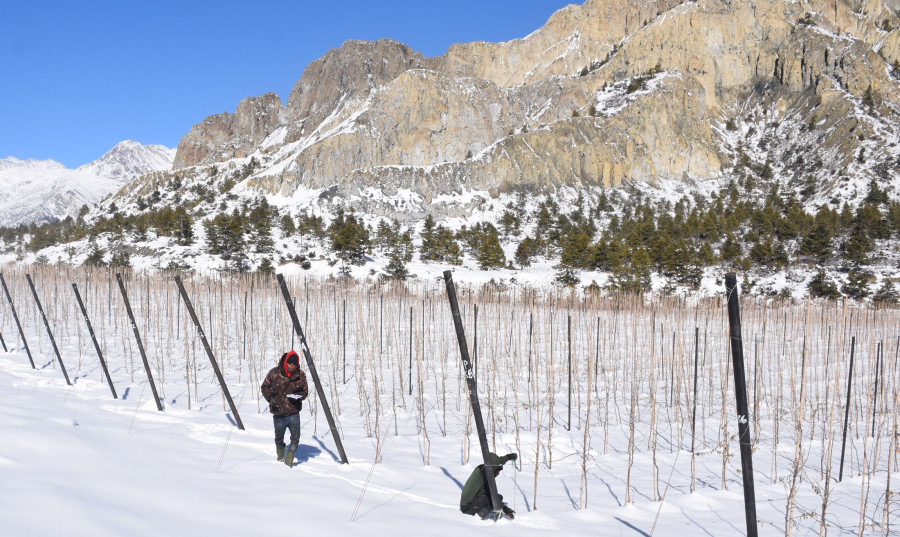Money
Apple farmers in Manang grow new varieties at higher altitudes
Apple is grown on 11,186 hectares in Nepal, with an annual output of 31,386 tonnes.
Aash Gurung
Apple farmers in the Himalayan district of Manang are moving northwards to higher elevations to try to grow a new variety of the fruit in a bid to benefit from higher temperatures caused by climate change.
They are experimenting with farming methods by planting a new species in sparsely vegetated areas at high altitudes.
If the experiment succeeds, farmers will be able to harvest apples during the winter season too when this area close to the Chinese border is normally blanketed in snow.
Agro Manang, which aims to build the biggest apple orchard in South Asia, has been farming apples commercially by using high density farming technology in Manang Ngisyang Rural Municipality-1, Bhratang.
They are now moving northwards to experiment with new varieties for commercial production on land which is covered in snow round the year.
Agro Manang has piloted the Red Jonaprince variety in Manang Ngisyang Rural Municipality-5, Sabjey which lies at an altitude of 3,300 metres above sea level, moving up around 500 metres from the usual growing areas in the Himalaya.
The orchard contains 18,000 apple saplings which were planted in mid-April last year, and they are expected to bear fruit for the first time in mid-October.
Fruit producers in the hilly and mountain regions are seeing a rise in temperature. For this reason, the production of apples has shifted to higher altitudes which were formerly unsuitable for growing this fruit, said apple growers.
“All the plants are now in full bloom,” said Yubaraj Gurung, managing director of the orchard which has been named Sabjey Farm. “We have also planted Gala apples as pollination partners for Red Jonaprince apple trees.”
The new apple orchard is spread over 400 ropanis (20 hectares). Gurung said that 75 people established Sabji Farm. “This year, 9,000 apple saplings have been planted out of the planned 35,000 saplings,.”
The farm expects to produce 45 tonnes of apples this October from the first batch of trees.
According to Gurung, the new varieties of apple saplings were imported from Italy. Red Jonaprince apple was first discovered in Holland in 1994. Its mutant is Jonagold. It is called 'the prince of apples' in Europe.
Red Jonaprince is watery and hard; it tastes slightly pungent and its inner colour is creamy yellowish. The fruit is large, rounded and conical in shape. The pulp is sweet, crisp and very juicy.
Its outer rind colour is red and gets red very early. Harvest time is the middle of September and October. This apple can be stored very well. Its speciality is that it is a high nutritional value type of apple.
“This variety ripens a little faster than the Fuji variety but a little slower than the Gala variety,” said Gurung.
The new apple farm project was started with an initial investment of Rs65 million including with Rs50 million in bank loans.
Tshering Ghale, chairman of the farm, said that Gandaki province had supported them with subsidised apple saplings.
“We received a 70 percent subsidy on 10,770 apple saplings,” he said, adding that the Prime Minister’s Agriculture Modernisation Project had given a 50 percent subsidy on 4,000 apple saplings.
The local government of the rural municipality has provided a 50 percent subsidy on 3,300 saplings. The saplings are imported from Italy and cost Rs1,150 each, said Ghale.
Senam Gurung, a local farmer, has planted 6,000 apple trees on 120 ropanis of land between Braga and Manang villages of Ngisyan applying 'high density' technology. He said that the saplings planted in his orchard in mid-April last year will start bearing fruit by mid-October.
"We import one-year-old saplings from Italy and plant them in Nepal, and they start yielding fruit after another year and a half.”
Agro Manang has been cultivating apples for the last five years. The farm has been growing apples on an orchard spread over 450 ropanis. The saplings are imported from Italy and Serbia.
Agro Manang has produced 400 tonnes of apples this year and has started exporting them. The orchard has different varieties like Gala, Fuji and Golden, which are grown at an altitude of 2,900 metres above sea level.
Apple is grown on 11,186 hectares in Nepal, with an annual output of 31,386 tonnes.
Jumla is the largest apple producing district with an annual output of 6,799 tonnes followed by Mustang with 5,727 tonnes, according to the statistics of the Ministry of Agriculture and Livestock Development.




 12.12°C Kathmandu
12.12°C Kathmandu.jpg)














